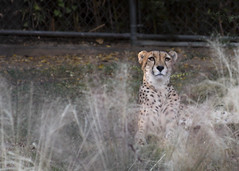
 For two years my Canon Rebel (300d) has been my faithful companion, constantly by my side, and ever ready to capture the moment. But such relationships are not destined to last forever. In a tragic fit of forgetfulness, I left my camera bag on the ground behind the car while packing for Maker Faire. A few distractions and a run inside to get my phone was all it took.
For two years my Canon Rebel (300d) has been my faithful companion, constantly by my side, and ever ready to capture the moment. But such relationships are not destined to last forever. In a tragic fit of forgetfulness, I left my camera bag on the ground behind the car while packing for Maker Faire. A few distractions and a run inside to get my phone was all it took.
The thump was sickening. Cautiously I stopped, got out and retrieved my scuffed camera bag from the driveway. The UV filter on my big Sigma was shattered, but the lens seemed OK. Turning the camera around revealed that the top LCD is shattered. Maybe out of hope, or just morbid curiosity I flipped the camera on, and took a peek through the viewfinder. She was alive! Maimed, but alive. We limped through the Maker Faire in Program mode and still managed to get a lot of good photos, the focus was a bit soft, but good enough for the web.
Through a strange and all too coincidental stroke of luck the Canon 50d was released just days before our accident. My friends (and probably my wife) don’t believe it was a coincidence, but I swear it was! The next week was spent weighing the options and pouring over specifications. Originally I considered the slightly cheaper (and slightly slower) Canon 40d, but in the end the allure of a brand new camera won out. My very first new camera in almost 10 years.
The one feature of the 50d that swayed me away from the slightly cheaper 40d was the new 15.1 MP sensor. More mega pixels are not always better, but Canon has managed to increase the resolution and sensitivity while reducing the amount of noise and grain. I’m able to shoot in extremely low light without a flash and capture usable pictures. For the camera geeks, this means you can shoot at ISO 1600 with little or no noise and you can push the sensor to 6400 and even 12,800 if you don’t mind the noise.
Adding to the lure was the new Digic 4 processor, a burst mode of 6.3 fps, and near instant power on. The faster processor aids with image capture, better noise reduction, and very fast playback. I’m finally able to get the first shot off before the kids can blink. If you’ve tried shooting kids, with either a camera or nerf gun, you know just how fast they can move.

 Since I didn’t know how well my Sigma lens had survived I also opted to get the 50d with the 28-135mm IS lens. The IS stands for Image Stabilization and helps eliminate camera shake when shooting at slower shutter speeds. This lens, combined with the low noise, high ISO sensor allows for some very low light shooting without a flash. I find that shooting with natural light allows me to get more candid shots of the kids. One of mine is apt to pose with a cheesy grin, and the other just as often hides their face, so anything that helps me avoid notice is good.
Since I didn’t know how well my Sigma lens had survived I also opted to get the 50d with the 28-135mm IS lens. The IS stands for Image Stabilization and helps eliminate camera shake when shooting at slower shutter speeds. This lens, combined with the low noise, high ISO sensor allows for some very low light shooting without a flash. I find that shooting with natural light allows me to get more candid shots of the kids. One of mine is apt to pose with a cheesy grin, and the other just as often hides their face, so anything that helps me avoid notice is good.
While I love the 50d dearly and wouldn’t part with it now, I would urge some caution for those of you interested in your first Digital SLR. The Canon Rebel XS can be bought (with lens) for about 1/3 the price and is capable of taking some awesome pictures. If you later decide you need more camera you can hand the XS down to your Geeklet and buy the Canon 50d with 28-135mm IS lens for yourself.
For some sample photos, you can check out our trip to the Dallas Zoo the weekend before last. I was very happy with both the camera and the lens. My favorite was this picture of a curious Cheetah.
![Reblog this post [with Zemanta]](http://img.zemanta.com/reblog_e.png?x-id=3de9f465-9b52-472f-9a99-b57b728362ca)

